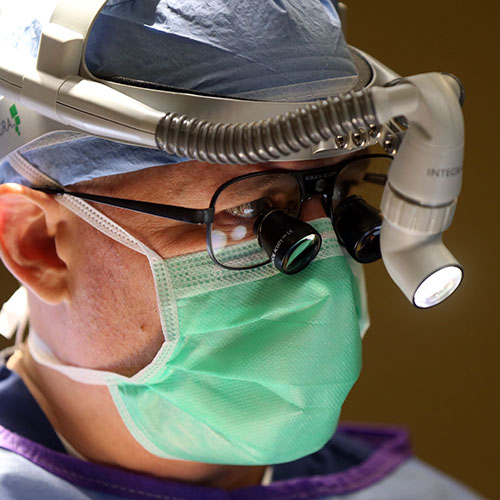Physical Therapist Partner
Physical therapy is a crucial component for a rapid, complete recovery after many types of traumatic injuries or surgical procedures. Physical therapists usually spend much more time with patients than any other member of the healthcare team. Often it is the physical therapist who first picks up on the fact that a specific patient is not progressing appropriately as time passes. One of the most common reasons for falling of the normal “recovery curve” is that the patient continues to experience significant pain long after typical patients have already achieved full recovery. What is going on with the TKA patient who is still tearing up due to severe “knee pain” at the 18 month post-op mark during PT while the majority of TKA patients are back out on the golf course at 3-4 months after surgery?
The great secret is that many if not most of these “underachievers” are probably suffering from some type of undiagnosed peripheral nerve pathology. That could include anything from nerve compression or direct injury to the nerve, to the nerve being entrapped or tethered in scar tissue resulting in painful stretching. The problem with patients suffering from peripheral nerve damage is that they often look totally normal. In the TKA patient example above, a thorough work-up to rule out infection, implant defect, or surgical error will often be completely negative. Despite this, the patient still complains of relentless, severe anterior knee pain, even after the arthritic joint has been totally replaced.
How does this happen? The answer is quite simple.
The great secret is that many if not most of these “underachievers” are probably suffering from some type of undiagnosed peripheral nerve pathology. That could include anything from nerve compression or direct injury to the nerve, to the nerve being entrapped or tethered in scar tissue resulting in painful stretching. The problem with patients suffering from peripheral nerve damage is that they often look totally normal. In the TKA patient example above, a thorough work-up to rule out infection, implant defect, or surgical error will often be completely negative. Despite this, the patient still complains of relentless, severe anterior knee pain, even after the arthritic joint has been totally replaced.
How does this happen? The answer is quite simple. The patient is most likely suffering from some type of unaddressed peripheral nerve injury. You see, when the arthritic joint is (rather violently) removed, all of the sensory innervation to the knee joint as well as the soft tissue envelope surrounding it are left behind. In many cases, these rather small sensory nerves end up forming painful neuromas or become entrapped in scar tissue. These are the patients that may continue to experience severe knee pain long after the typical TKA patient has already been discharged. In this setting, it doesn’t matter how long the patient participates in PT or how many additional orthopedic procedures they undergo, their pain will never get better.
The great news is that there is now a new field of surgery tailored towards operating on the peripheral nervous system with a specific focus on eliminating chronic pain of nerve origin. This new approach really illuminates an area that until very recently has been a huge blind spot in the recognition and treatment of chronic pain. The problem really begins with the fact that physicians across the spectrum learn almost nothing about peripheral nerve anatomy and even less about how peripheral nerve problems present. This educational deficiency spans the arc from medical school all the way through the last day of fellowship training. As a result, once a patient develops chronic pain, the fact of it’s existence is just sort of accepted and therapy shifts gears from trying to identify and eliminate the source of the pain to just treating the pain itself. At that point, the patient is pretty much doomed to a lifetime of “pain management” and narcotic addiction.

Essentially, the connection between the peripheral nervous system and chronic pain has fallen into the category of, “The eye cannot see what the mind does not know.” As a result, much of the pain, due in fact to some type of peripheral nerve problem, is often assigned to some other “recognized” cause, usually referable to the musculoskeletal system. In this sense, peripheral nerve pathology is also the “great mimicker.” It can be misdiagnosed as joint pain, spine pathology, muscle or ligament pathology, and the list goes on and on. Compression or injury of the lateral femoral cutaneous nerve (meralgia paresthetica), for example, is frequently misdiagnosed as hip or knee joint pathology, inguinal hernia, IT band syndrome, hip flexor dysfunction, or “sciatica” or radicular pain. These misdiagnoses can lead to patients pursuing all kinds of pointless therapies and even result in total hip or knee replacement.
Once the blinders have been lifted, however, you will find that the amount of diagnosable and correctable peripheral nerve pathology floating around in your patient population masquerading as all sorts of other things or just plain old “undiagnosable” chronic pain is immense. So how does one go from groping in the dark to seeing with 20/20 vision? Well, the good news is that it’s actually not that hard to start spotting peripheral nerve patients once you know what to look for. Just knowing the possibility of a peripheral nerve problem existing and keeping that in mind is half the battle. Here are a few guidelines to keep in mind next time you have a patient struggling with “chronic pain” or some other musculoskeletal diagnosis that just doesn’t respond to treatment like it should.
